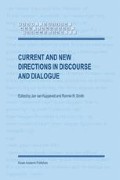Abstract
The paper addresses the issue of how to increase adaptivity in response generation for a spoken dialogue system. Realization strategies for dialogue responses depend on communicative confidence levels and interaction management goals. We first describe a Java/XML-based generator which produces different realizations of system responses based on agendas specified by the dialogue manager. We then discuss how greater adaptivity can be achieved by using a set of distinct generator agents, each of which is specialized in its realization strategy (e.g. highly elliptical or highly explicit). This allows a simpler design of each generator agent, while increasing the overall system adaptivity to meet the requirements for flexible cooperation in incremental and immediate interactive situations.
Access this chapter
Tax calculation will be finalised at checkout
Purchases are for personal use only
Preview
Unable to display preview. Download preview PDF.
References
Allwood, J. (1976). Linguistic Communication as Action and Cooperation. Department of Linguistics, University of Geteborg. Gothenburg Monographs in Linguistics 2.
Apache XML Project (2001). Xalan-Java. http://xral.apache.org/xalan-j/.
Carlson, L. (1988). Questions of identity in discourse. In Meyer, M., editor, Questions and Questioning, pages 144–181. Walter de Gruyter, Berlin.
Cawsey, A. (2000). Presenting tailored resource descriptions: Will XSLT do the job? In 9th International World Wide Web Conference. http://www9.org/w9cdrora/.
Chafe, W. (1976). Givenness, contrastiveness, definiteness, subjects, and topics. In Li, C., editor, Subject and Topic. Academic Press.
Danieli, M. and Gerbino, E. (1995). Metrics for evaluating dialogue strategies in a spoken language system. In Proceedings of the AAAI Spring Symposium on Empirical Methods in Discourse Interpretation and Generation, pages 34–39.
Deemter, K. v., Krahraer, E., and Theune, M. (1999). Plan-based vs. template-based NLG: A false opposition? In Becker and Busemann (1999), pages 1–5.
Jokinen, K. (2000). Learning dialogue systems. In Dybkjaer, L., editor, LREC 2000 Workshop: From Spoken Dialogue to Full Natural Interactive Dialogue — Theory, Empirical Analysis and Evaluation, pages 13–17, Athens.
Jokinen, K. (2001). The Interact project. Elsnews, 10.2:10.
Jokinen, K., Hurtig, T., Kevin Hynna, Kanto, K., Kaipainen, M., and Kerminen, A. (2001). Self-organizing dialogue management. In Proceedings of 2nd Workshop on NLP and Neural Networks, NLPRS-2001, Tokyo.
Jokinen, K., Tanaka, H., and Yokoo, A. (1998). Planning dialogue contributions with new information. In Proceedings of the Ninth International Workshop on Natural Language Generation, pages 158–167, Niagara-on-the-Lake, Ontario.
Kume, M., Sato, G. K., and Yoshimoto, K. (1989). A descriptive framework for translating speaker’s meaning: Towards a dialogue translation system between Japanese and English. In Fourth Conference of the European Chapter of the Association for Computational Linguistics, pages 264–271, Manchester.
Kuppevelt, J. v. (1991). Topic en Comment. Expliciete en Impliciete Vraagstelling in Discourse. PhD thesis, University of Nijmegen.
Litman, D. and Pan, S. (2000). Predicting and adapting to poor speech recognition in a spoken dialogue system. In Proceedings of the Seventeenth National Conference on Artificial Intelligence (AAAI-2000), pages 722–728, Austin, TX.
Moore, J. (1995). Participating in Explanatory Dialogues. MIT Press.
Reiter, E. and Dale, R. (2000). Building Natural Language Generation Systems. Cambridge University Press.
Theune, M. (2000). From Data to Speech: Language Generation in Context. PhD thesis, Eindhoven University of Technology.
Traum, D. and Allen, J. F. (1994). Discourse obligations in dialogue processing. In 32nd Annual Meeting of the Association for Computational Linguistics, pages 1–8, Las Cruces.
Turunen, M. and Hakulinen, J. (2000). Jaspis — a framework for multilingual adaptive speech applications. In Proceedings of 6th International Conference on Spoken Language Processing, Beijing.
VoiceXML Forum (2000). Voice extensible Markup Language VoiceXML, Version 1.00. http://www.voicexml.org/spec.html.
Walker, M., Litman, D., Kamm, C., and Abella, A. (1998). Evaluating spoken dialogue agents with PARADISE: Two case studies. Computer Speech and Language, 12–3.
Wilcock, G. (2001). Pipelines, templates and transformations: XML for natural language generation. In Proceedings of the 1st NLP and XML Workshop, pages 1–8, Tokyo.
Wilcock, G. and Jokinen, K. (2001). Design of a generation component for a spoken dialogue system. In Proceedings of the 6th Natural Language Processing Pacific Rim Symposium (NLPRS-2001), pages 545–550, Tokyo.
Author information
Authors and Affiliations
Editor information
Editors and Affiliations
Rights and permissions
Copyright information
© 2003 Springer Science+Business Media Dordrecht
About this chapter
Cite this chapter
Jokinen, K., Wilcock, G. (2003). Adaptivity and Response Generation in a Spoken Dialogue System. In: van Kuppevelt, J., Smith, R.W. (eds) Current and New Directions in Discourse and Dialogue. Text, Speech and Language Technology, vol 22. Springer, Dordrecht. https://doi.org/10.1007/978-94-010-0019-2_10
Download citation
DOI: https://doi.org/10.1007/978-94-010-0019-2_10
Publisher Name: Springer, Dordrecht
Print ISBN: 978-1-4020-1615-8
Online ISBN: 978-94-010-0019-2
eBook Packages: Springer Book Archive

